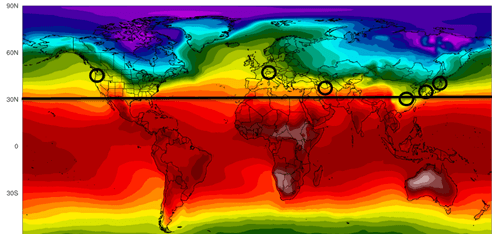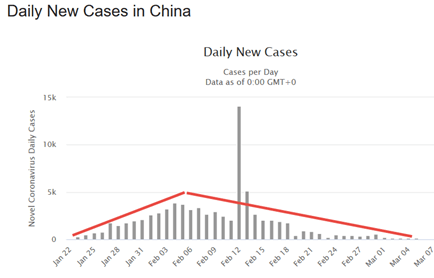Thoughts on the Wuhan
I’m not an infectious disease specialist (but I certainly know a great deal more than I did two weeks ago!), so take the following thoughts as those of a recently informed non-medical person who is a battle-scarred veteran of almost 39 years in the investment business.
Market Panic
I believe that the market reaction to this virus qualifies as a panic. Here’s why. Though there are still a number of uncertainties regarding its health and economic effects, there are a couple of fairly certain “knowns:”
- The lethality rate is similar to the seasonal flu. Most estimates that I have seen range from 3.5% to .1%. The wide range stems from the fact that it is generally assumed that there are many mild cases that have gone unreported. If the only true cases are the ones that have been reported, the death rate is around 3.5%. The higher the number of unreported cases, the closer the mortality rate gets to .1%. We know the numerator; the denominator is uncertain, and the more it increases, the lower the lethality rate. When you see a claim in the media that says the Wuhan is more deadly than the seasonal flu, you are probably seeing an apples and oranges comparison, in which the coronavirus rate is based on the number of tested cases, and that of the flu on the number of estimated cases.
- Mortality rates in China and Italy, the two hardest hit countries, will probably significantly exceed those of the U.S.[1]
- There is a good chance that the Wuhan virus will follow a normal seasonal flu pattern. The hardest hit areas – Washington State, northern Italy, Iran, northern China, South Korea and Japan – all lie between 30 and 50 degrees north latitude.[2]

Why is this significant? Flu season ends as the weather gets warmer. It was initially assumed that the virus would rapidly spread into Southeast Asia, but that hasn’t happened, in all probability because humid, warm weather is the flu’s kryptonite. By my calculations, 98% of the cases are above 30 degrees north latitude.[3] We should see a reduction in the number of new cases in the U.S. as we get closer to summer.
- Farr’s Law of Epidemics says that epidemics tend to rise and fall in a roughly symmetrical pattern or bell shaped curve.[4] Here is the pattern so far in China. (I strongly recommend the Worldometers site I have referenced below to keep track of this.) The two large upward spikes around 2/12 are actually a latent recognition of earlies cases. The rise and fall in cases probably looks like the red lines I have drawn. It is reasonable to assume this pattern will repeat in the U.S., though it may well be lengthened by our cancellation of large gatherings (perversely this will help hospitals by stretching out the spread so they are not overburdened, but make the epidemic last longer). On the other hand, warming temperatures may shorten the time the epidemic endures.

- The U.S. economy was in very good shape before the virus spread from China. See my blog post from 2/28/20 The Corona Quake http://capitalistinvestment.com/blog/2020/02/28/The-Corona-Quake
Given all of the above “knowns,” I believe that though the economy will take a hit from this, the stock market will rebound as U.S. new cases diminish, perhaps following a pattern similar to that of China. It would not surprise me that this rebound is accompanied by a buying panic that leads to one of the largest single day market gains of all time.
Cancellations
It’s easy to ridicule many of the cancellations, and much of the government’s response to the virus. But some of it makes sense and is perfectly understandable. Very large public gatherings such as music festivals, where people gather from all over the world, are certainly a nexus for the contraction and spread of the disease. Children seem to be significantly less affected than adults, which can make them unnoticed carriers, so closing schools is probably wise.
With that said, some of the cancellations are simply absurd. Here are two personal examples:
- Last Thursday night, we were scheduled to have our monthly meeting of the local chapter of the Nashville Songwriters Association International in my office. This usually involves 5-8 people. We got an email from the national organization saying that all chapter meetings needed to be cancelled. Why? Because someone in another state had attended a chapter meeting, felt ill afterwards, and was subsequently tested for the virus. He didn’t have it, but all meetings were still cancelled!
- The Blackwater National Refuge in Dorchester County on the eastern shore of Md. is home to the largest population of snakehead in the state. If you’re not familiar with it, the Northern Snakehead is an invasive species from China that was ignorantly introduced into Md. about 20 years ago. They are now thriving in almost every tributary of the Chesapeake. It was expected that with spring upon us, many fishermen would be heading to the Blackwater last weekend, so they closed the refuge. Think about that for a minute. There are probably going to be a few hundred folks there spread across a few thousand acres of ponds, streams and marsh. If you’ve ever done any bank fishing, you know that it is harshly enforced etiquette that you don’t get within 40 yards of another fisherman. At best you get the stink eye, and at worst a fist fight ensues.
Sometimes laughter is the best medicine!
Don Harrison 3/13/20
[1] As the number of corona virus cases rises, why is Italy being hit so hard?, ABC News
[2]Temperature and latitude analysis to predict potential spread and seasonality for COVID-19, Mohammad M. Sajadi,MD,Parham Habibzadeh,MD,AugustinVintzileos, PhD,Shervin Shokouhi,MD,Fernando Miralles-Wilhelm, PhD,Anthony Amoroso, MD
[3] Worldometers info, https://www.worldometers.info/coronavirus/#countries
[4] Why Are We Ignorning Farr’s Law of Epidemics?, David Paul Kirkpatrick, https://medium.com/@davidpkirkpatrick/why-are-we-ignoring-farrs-law-of-epidemics-coronavirus-should-be-gone-by-summer-7782f3622c3a
The information contained in this report does not purport to be a complete description of the securities, markets, or developments referred to in this material. The information has been obtained from sources considered to be reliable, but we do not guarantee that the foregoing material is accurate or complete. Any opinions are those of Don Harrison, and not necessarily those of Raymond James. Expressions of opinion are as of this date and are subject to change without notice. There is no guarantee that these statements, opinions or forecasts provided herein will prove to be correct. Investing involves risk and you may incur a profit or loss regardless of strategy selected. Keep in mind that individuals cannot invest directly in any index, and index performance does not include transaction costs or other fees, which will affect actual investment performance. Individual investor’s results will vary. Past performance does not guarantee future results. Future investment performance cannot be guaranteed, investment yields will fluctuate with market conditions. The S&P 500 is an unmanaged index of 500 widely held stocks that is generally considered representative of the U.S. stock market. Forward looking data is subject to change at any time and there is no assurance that projections will be realized. All investments are subject to risk. Leading Economic Indicators are selected economic statistics that have proven valuable as a group in estimating the direction and magnitude of economic change.

